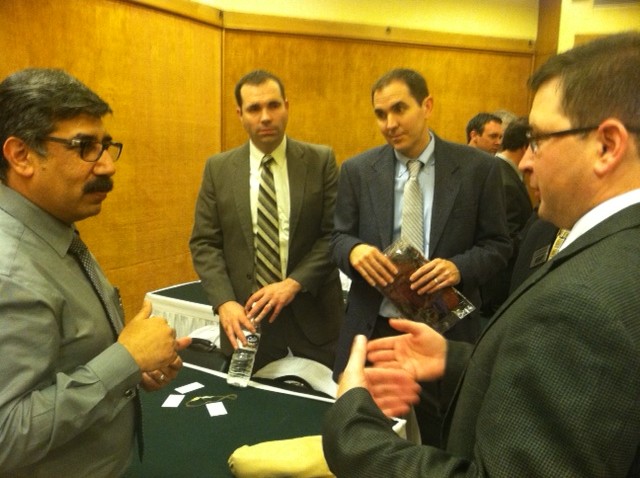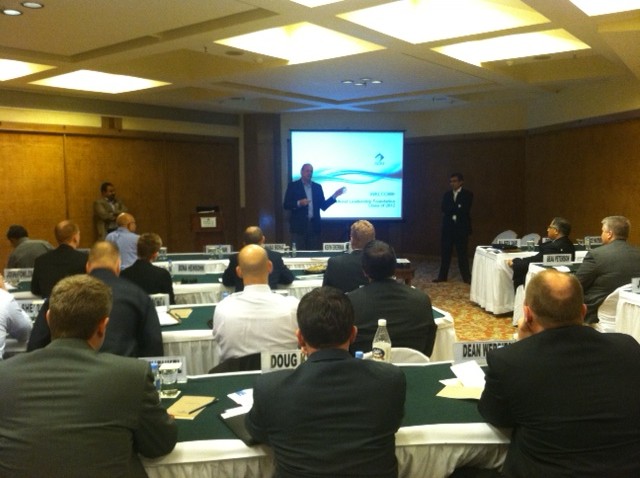We aren’t in China anymore! Around 1:30 am local time, which would have been 4:30 am in Beijing, we landed in New Dehli, India. Tired yet excited and eager to start the first day in India.
The forecast for our landing in India was for “smoke.” Upon landing and exiting the airport—we found out why. The air actually looked and smelled of smoke. Cause? Unknown to us but we’ve got the next few days to discover the origin.
Breakfast at the New Dehli Hyatt did not disappoint. For the first time this seminar, we had a chance to eat late and leisurely – but then, we arrived just before sunrise.
Some class members hit the hotel gym, other ventured out in the absolute chaos of India traffic and hit the shopping venues before our afternoon seminar. Once again, we had ample opportunity to test the negotiation skills we’d previously learned.
It’s hot and sunny here, quite a contrast to the snow and rain we experienced in China. Suits and ties will replace the overcoats of China.
Our motor coach left the hotel headed for the Habitat World, India Habitat Centre. The ride there allowed us to get a closer view of the streets in New Delhi. Obviously, they live much differently than we do, but they are a happy people, an active people and an especially friendly people.
 The afternoon seminar was hosted at the Habitat World, India Habitat Centre by ADM of India. The first presenter was Amit Sachdev of the US Grains Council. Amit set the stage with statistics regarding the massive population growth of Asia–India in particular. It is estimated that India will surpass China in population by 2025. With that kind of growth there will be many challenges, including pressure on natural resources and food needs. Some of the statistics we found interesting were that the people of India spend about 60% of their income on food, and India is experiencing a shortage of available water, with 80% of water being used for agriculture. Water has become the most expensive commodity today. The Indian farmers have subsidies in the form of free electricity and the fertilizers are subsidized. The over use of Urea has been a problem; since it was subsidized by the government it was being over applied.
The afternoon seminar was hosted at the Habitat World, India Habitat Centre by ADM of India. The first presenter was Amit Sachdev of the US Grains Council. Amit set the stage with statistics regarding the massive population growth of Asia–India in particular. It is estimated that India will surpass China in population by 2025. With that kind of growth there will be many challenges, including pressure on natural resources and food needs. Some of the statistics we found interesting were that the people of India spend about 60% of their income on food, and India is experiencing a shortage of available water, with 80% of water being used for agriculture. Water has become the most expensive commodity today. The Indian farmers have subsidies in the form of free electricity and the fertilizers are subsidized. The over use of Urea has been a problem; since it was subsidized by the government it was being over applied.
Our second speaker of the day was Kevin Eikerman of ADM. Kevin informed us that ADM is in its third year doing business here. They entered the market in a joint venture with another company and have worked toward a transition of 100% ownership. ADM went about the market much differently than many companies have; building a relationship of trust with the farmers buying directly from them – an  innovation here. Kevin shared surprising statistics to us that India is about one third the size of the United States with about the same amount of arable land, and 60% of all people in India have something to do with agriculture. Some of the challenges facing the processing industry that ADM is involved in is that the industry is highly over capacity, the industry is also highly fragmented needing consolidation to make it profitable, and ag policy is complex. For example agriculture in India is overseen and regulated by State Government not Central Government and there is no long term policy to make the farmer or industry competitive.
innovation here. Kevin shared surprising statistics to us that India is about one third the size of the United States with about the same amount of arable land, and 60% of all people in India have something to do with agriculture. Some of the challenges facing the processing industry that ADM is involved in is that the industry is highly over capacity, the industry is also highly fragmented needing consolidation to make it profitable, and ag policy is complex. For example agriculture in India is overseen and regulated by State Government not Central Government and there is no long term policy to make the farmer or industry competitive.
We continued our panel of presenters with Shailu Verma from GSI. He spoke to us about the opportunities and more overwhelming challenges to the economics of farm storage in India. Shailu opened with the statement that the country of India is only about 50 years old from a growth perspective. There are obvious opportunities in our minds since there is no developed grain storage system or infrastructure. But the challenges seem to be overwhelming. There are extremely small farms, the mechanization is limited and bulk handling does not exist at the farm level. Government price controls and procurement control make it difficult for the Indian farmers to understand the benefits of storage. The anti-hoarding laws that apply to processors and wholesalers restrict storage to a 30-day supply. In many regions there are multiple cropping seasons which adds to the storage challenge.
Our final speaker was Rajeev Dar, Chairman and CEO of the Indian Society for Agribusiness Professionals. He emphasized the need to educate adult farmers, a process he referred to as “social investment.” Over three-year studying and working with 3,000 farmers, they added $3 million of value at the farm level. In addition, their training programs have helped farmers double and even triple their production.
We wrapped up the afternoon with authentic, carbonated Indian spirits and a buffet of Indian appetizers. We are very appreciative of ADM sponsoring today’s session and reception.
No responses yet